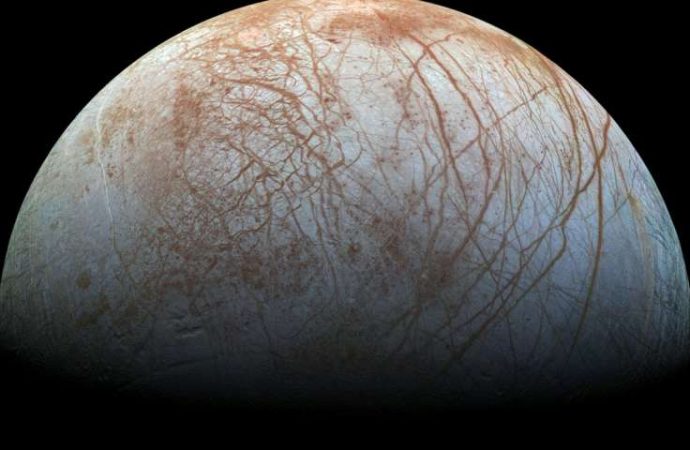A fresh look at data from a 1997 flyby of Jupiter’s moon, Europa, suggests that NASA’s Galileo spacecraft flew directly through a watery plume, raising hopes of probing the jets for signs of life around the second planet from Earth.
The revelations Monday came after scientists revisited a puzzling reading from an instrument aboard Galileo, which in 1995 became the first spacecraft to enter the orbit of a gas giant planet.
What they found was the most direct evidence yet of plumes emerging from Europa’s frozen surface, researchers reported in the scientific journal Nature Astronomy.
Europa has long been thought to cover a salty ocean about twice the size of our planet’s.
Given the suspected abundance of warm, liquid water under its thick ice shell, the moon is considered a “top candidate” by NASA for life on a solar system body other than Earth.
In the last several years, NASA’s Hubble Space Telescope has detected evidence of plumes on Europa, but from afar.
Galileo came much closer during its 11 flybys of Europa.
“On one particular pass by Europa, the spacecraft came very, very close to the surface—as I remember less than 150 kilometers (93 miles) above the surface—and it was on that pass that we saw signatures that we never really understood,” said Margaret Kivelson, professor emerita of space physics at the University of California, Los Angeles, on NASA TV.
That region was in an area where the Hubble Space Telescope had spotted repeated evidence of plumes.
When another researcher presented findings recently on Hubble’s collection of observations, “that led us to realize we had to go back and look at Galileo data,” said Xianzhe Jia, associate professor at the University of Michigan, Ann Arbor.
For the new study, experts measured variations in the moon’s magnetic field and plasma waves, based on data obtained during Galileo’s close flyby, and found they were “consistent” with the spacecraft crossing a plume.
“These results provide strong independent evidence of the presence of plumes at Europa,” they wrote in Nature.
The team reconstructed the spacecraft’s path to pinpoint the plume’s location on the moon’s surface.
“These findings will help plan future missions to Europa, such as NASA’s Europa Clipper and ESA’s Jupiter Icy Moons Explorer spacecraft, both of which are expected to arrive at Jupiter between the late 2020s and early 2030s,” said a Nature summary.
Questions remain
NASA reported evidence twice before, from its Hubble Space Telescope, of the existence of water plumes on Europa, though this interpretation has caused much debate.
And many questions remain about what is contained in the plumes, and whether that includes some form of life.
Elizabeth Turtle, research scientist at Johns Hopkins Applied Physics Laboratory in Laurel, Maryland, said the subsurface ocean “is likely the most habitable part of Europa because it is warmer and it is protected from the radiation environment by the ice shell.”
And if plumes erupt like geysers, “there may be ways for that material from the ocean to come out above that ice shell and that means we would be able to sample it,” she said.
The report was described by NASA as “good news” for its unmanned Europa Clipper mission, an $8 billion endeavor on track to launch as early as June 2022 and plans a series of low-altitude flybys of Europa when it could sample the frozen liquid and dust particles.
“There now seem to be too many lines of evidence to dismiss plumes at Europa,” said Robert Pappalardo, Europa Clipper project scientist at NASA’s Jet Propulsion Laboratory in Pasadena, California.
“If plumes exist, and we can directly sample what’s coming from the interior of Europa, then we can more easily get at whether Europa has the ingredients for life,” he said in a statement.
“That’s what the mission is after. That’s the big picture.”
Galileo launched in 1989 to examine the fifth planet from the Sun.
Before ending its mission in 2003 with a planned crash into Jupiter’s atmosphere, Galileo reported the first data suggesting a liquid water ocean under Europa’s surface.
Source: Phys.org

































Leave a Comment
You must be logged in to post a comment.